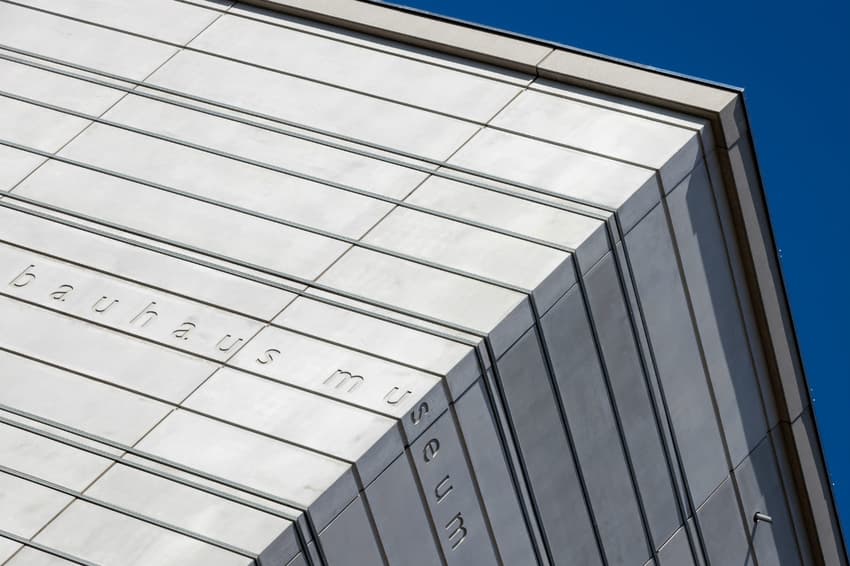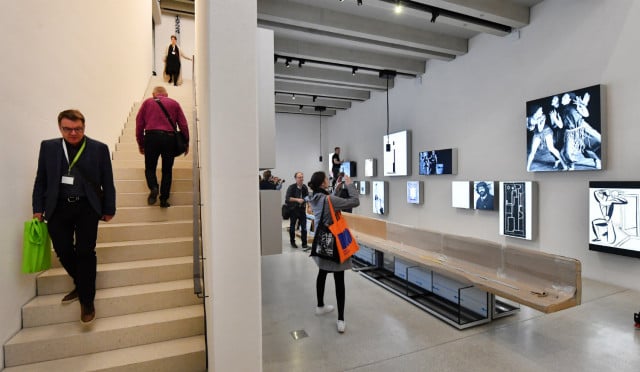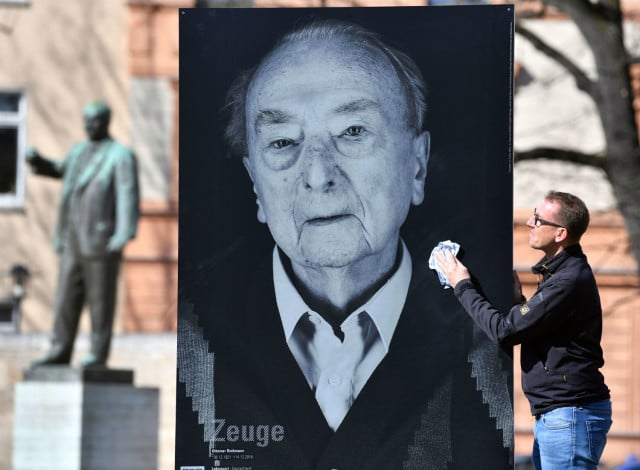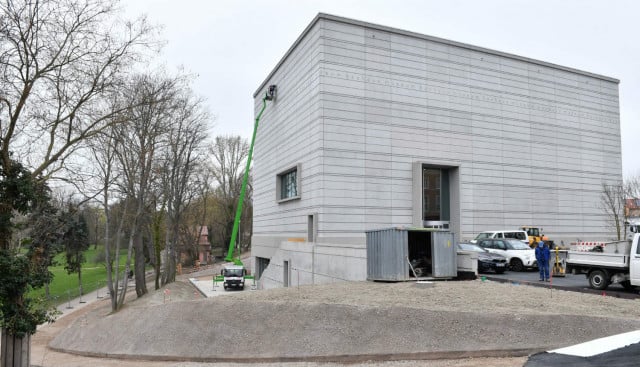Inside Weimar's new politically charged Bauhaus museum

The Bauhaus design school, which transformed the way people around the world live, work and dream of the
future, marks its centenary this week with the launch of a politically charged German museum.
Founded on April 1st, 1919 during the rocky period between the world wars and finally driven out by the Nazis, Bauhaus still has the power to inspire and divide in today's own turbulent era.
The sprawling museum in Bauhaus's birthplace of Weimar, a small city 250 kilometres southwest of Berlin, will open to the public Saturday and display the classics of its less-is-more, form-follows-function aesthetic.
SEE ALSO: Iconic creations of Bauhaus designs, 100 years on
The inauguration of the minimalist temple housing the world's oldest Bauhaus collection comes just weeks ahead of European elections and six months before a key poll in Weimar's state of Thuringia.
The far-right Alternative for Germany (AfD) looks poised to make strong gains in each vote.
"Of course you can't see this opening separate from its political context," Wolfgang Holler, director of Weimar's museums, told AFP.
 Inside the new museum. Photo: DPA
Inside the new museum. Photo: DPA
"Bauhaus was, from the very beginning, intensely political. And so it's a perfect place to start a conversation, especially with young people."
Faces of camp survivors
Weimar selected a highly symbolic design and location for the building.
German architect Heike Hanada placed her concrete cube just outside the picturesque old town where literary giants Goethe and Schiller cemented the small city's elevated place in Germany's cultural landscape.
The €22.6 million museum is framed on one side by a recreational space created under the inter-war Weimar Republic, Germany's ill-fated first experiment with democracy.
SEE ALSO: How Bauhaus designed the world as we know it
On another side is a model housing block built under East Germany's communists.
Crucially, the Bauhaus Museum Weimar stands opposite the former Gauforum, a U-shaped colossus built by the Nazis to house, among other things, administrative offices for their slave labour programme.
"I was able to achieve my main goal, which was for the museum to be able to stand up to the Nazi architecture in the neighbourhood," Hanada told the daily Thüringer Allgemeine.
"It becomes plain here what happens when you heedlessly run after certain ideologies," Holler said. "These fascinating juxtapositions say so much about how this country sees itself."
This week, Weimar hung larger-than-life contemporary photographs of survivors of the Nazis' former Buchenwald concentration camp, whose memorial can be seen in the distance through a specially-placed picture window on the museum's top floor.
The haunting images of the now elderly faces line the road from the main train station to the museum.
 The photographer Thomas Müller with a portrait of a survivor of Buchenwald concentration camp. Photo: DPA
The photographer Thomas Müller with a portrait of a survivor of Buchenwald concentration camp. Photo: DPA
Photographer Thomas Müller said they were also meant to challenge the AfD, whose co-leader Alexander Gauland has called the Nazi era a "speck of bird shit in more than 1,000 years of successful German history".
"Especially in view of the Thuringia election, we have got to deal with our history responsibly," Mueller told German radio.
'Ahead of their time'
The Bauhaus school, which counted Russian abstract painter Wassily Kandinsky and Swiss-born surrealist Paul Klee among its proponents, had at its core the idea of making beautiful, practical design accessible to the masses.
The museum traces how founder Walter Gropius and the Bauhaus, deemed subversive by the then ultra-right government in Weimar, were forced to move east to Dessau then to Berlin before the Nazis ran them out of Germany for good.
SEE ALSO: 'Rethinking the world': Bauhaus celebrates 100 years
Bauhaus's acolytes ended up sowing seeds wherever they landed, from Tel Aviv to Chicago. Today, everything from iPhones to Ikea furniture bear the mark of its keep-it-simple tenets.
Most observers have praised Hanada's boxy museum design as a worthy tribute to the Bauhaus look.
However some have criticized the elimination of a glass facade, which they say gives the building an unfortunate resemblance to a wartime bunker.
"Some have even compared it to the Wolf's Lair," Hitler's Eastern Front headquarters, Holler admitted.
 The museum is nearly ready to open to the public. Photo: DPA
The museum is nearly ready to open to the public. Photo: DPA
"But we wanted something that would say, 'We aren't cowering away -- we're making our presence felt'."
The exhibition, expected to draw 100,000 visitors a year, includes icons such as Marcel Breuer's tubular steel and leather chairs, Marianne Brandt's whimsically angular teapots, and a multicoloured circles-and-triangles cradle by Peter Keller.
It ultimately aims to examine why Hitler saw such a dangerous enemy in Bauhaus, and how it became one of the few cherished German legacies from the early 20th century.
"You learn here how hard it can be for those who are ahead of their time," Holler said.
By Deborah Cole
Comments
See Also
Founded on April 1st, 1919 during the rocky period between the world wars and finally driven out by the Nazis, Bauhaus still has the power to inspire and divide in today's own turbulent era.
The sprawling museum in Bauhaus's birthplace of Weimar, a small city 250 kilometres southwest of Berlin, will open to the public Saturday and display the classics of its less-is-more, form-follows-function aesthetic.
SEE ALSO: Iconic creations of Bauhaus designs, 100 years on
The inauguration of the minimalist temple housing the world's oldest Bauhaus collection comes just weeks ahead of European elections and six months before a key poll in Weimar's state of Thuringia.
The far-right Alternative for Germany (AfD) looks poised to make strong gains in each vote.
"Of course you can't see this opening separate from its political context," Wolfgang Holler, director of Weimar's museums, told AFP.
 Inside the new museum. Photo: DPA
Inside the new museum. Photo: DPA
"Bauhaus was, from the very beginning, intensely political. And so it's a perfect place to start a conversation, especially with young people."
Faces of camp survivors
Weimar selected a highly symbolic design and location for the building.
German architect Heike Hanada placed her concrete cube just outside the picturesque old town where literary giants Goethe and Schiller cemented the small city's elevated place in Germany's cultural landscape.
The €22.6 million museum is framed on one side by a recreational space created under the inter-war Weimar Republic, Germany's ill-fated first experiment with democracy.
SEE ALSO: How Bauhaus designed the world as we know it
On another side is a model housing block built under East Germany's communists.
Crucially, the Bauhaus Museum Weimar stands opposite the former Gauforum, a U-shaped colossus built by the Nazis to house, among other things, administrative offices for their slave labour programme.
"I was able to achieve my main goal, which was for the museum to be able to stand up to the Nazi architecture in the neighbourhood," Hanada told the daily Thüringer Allgemeine.
"It becomes plain here what happens when you heedlessly run after certain ideologies," Holler said. "These fascinating juxtapositions say so much about how this country sees itself."
This week, Weimar hung larger-than-life contemporary photographs of survivors of the Nazis' former Buchenwald concentration camp, whose memorial can be seen in the distance through a specially-placed picture window on the museum's top floor.
The haunting images of the now elderly faces line the road from the main train station to the museum.
 The photographer Thomas Müller with a portrait of a survivor of Buchenwald concentration camp. Photo: DPA
The photographer Thomas Müller with a portrait of a survivor of Buchenwald concentration camp. Photo: DPA
Photographer Thomas Müller said they were also meant to challenge the AfD, whose co-leader Alexander Gauland has called the Nazi era a "speck of bird shit in more than 1,000 years of successful German history".
"Especially in view of the Thuringia election, we have got to deal with our history responsibly," Mueller told German radio.
'Ahead of their time'
The Bauhaus school, which counted Russian abstract painter Wassily Kandinsky and Swiss-born surrealist Paul Klee among its proponents, had at its core the idea of making beautiful, practical design accessible to the masses.
The museum traces how founder Walter Gropius and the Bauhaus, deemed subversive by the then ultra-right government in Weimar, were forced to move east to Dessau then to Berlin before the Nazis ran them out of Germany for good.
SEE ALSO: 'Rethinking the world': Bauhaus celebrates 100 years
Bauhaus's acolytes ended up sowing seeds wherever they landed, from Tel Aviv to Chicago. Today, everything from iPhones to Ikea furniture bear the mark of its keep-it-simple tenets.
Most observers have praised Hanada's boxy museum design as a worthy tribute to the Bauhaus look.
However some have criticized the elimination of a glass facade, which they say gives the building an unfortunate resemblance to a wartime bunker.
"Some have even compared it to the Wolf's Lair," Hitler's Eastern Front headquarters, Holler admitted.
 The museum is nearly ready to open to the public. Photo: DPA
The museum is nearly ready to open to the public. Photo: DPA
"But we wanted something that would say, 'We aren't cowering away -- we're making our presence felt'."
The exhibition, expected to draw 100,000 visitors a year, includes icons such as Marcel Breuer's tubular steel and leather chairs, Marianne Brandt's whimsically angular teapots, and a multicoloured circles-and-triangles cradle by Peter Keller.
It ultimately aims to examine why Hitler saw such a dangerous enemy in Bauhaus, and how it became one of the few cherished German legacies from the early 20th century.
"You learn here how hard it can be for those who are ahead of their time," Holler said.
By Deborah Cole
Join the conversation in our comments section below. Share your own views and experience and if you have a question or suggestion for our journalists then email us at [email protected].
Please keep comments civil, constructive and on topic – and make sure to read our terms of use before getting involved.
Please log in here to leave a comment.